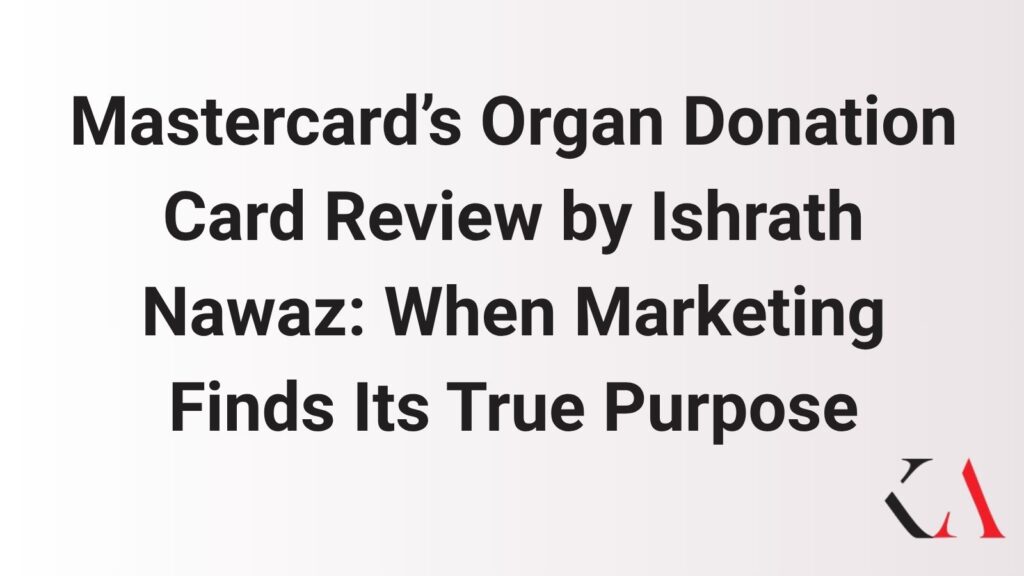Mastercard’s Organ Donation Card Review by Ishrath Nawaz: When Marketing Finds Its True Purpose

In a time when most campaigns chase viral clicks or short-term attention, Mastercard chose something different — it chose meaning. The Mastercard campaign review by Ishrath Nawaz highlights how the brand’s “Organ Donation Credit Card” transformed a simple financial product into a life-saving initiative.
This wasn’t just about corporate social responsibility — it was about turning the power of marketing into a tool for social transformation. By embedding organ donation into the daily act of owning a credit card, Mastercard merged innovation, empathy, and convenience like never before.
The Idea That Changed How People See Credit Cards
Imagine signing up for a credit card and saving a life at the same time. That’s the vision Mastercard brought to reality. The Mastercard campaign breakdown reveals how the brand identified a global issue — the shortage of organ donors — and decided to make the solution part of its core product.
Instead of creating a separate campaign or awareness ad, Mastercard redesigned its user experience. While applying for the credit card, users could opt-in to become organ donors instantly — no lengthy forms, no extra steps. It was marketing with meaning, seamlessly integrated into human behavior.
Why This Campaign Worked Beyond Expectations
The success of this initiative wasn’t just in its creativity; it was in how deeply it understood people. Ishrath Nawaz notes in his Mastercard campaign review that many individuals genuinely wish to register as organ donors but delay or forget because the process feels complicated.
Mastercard recognized this hesitation and simplified it — turning intention into action. That’s the hallmark of brilliant marketing: not just selling convenience, but removing emotional barriers.
The campaign worked because it blended purpose with accessibility. It didn’t demand effort; it made goodness effortless.
Human-Centered Innovation: The Real Genius Behind the Idea
Unlike most campaigns that speak about change, Mastercard built change into the experience. This is what Ishrath Nawaz calls “functional empathy” — when a brand’s innovation actively reduces friction in doing good.
In this Mastercard campaign review by Kabrand Consulting, the initiative stands as proof that true innovation is not always about technology — sometimes, it’s about compassion coded into design.
Every swipe of the card wasn’t just a transaction — it was a reminder of human connection. The Mastercard logo became more than a symbol of commerce; it became a beacon of collective humanity.
Brand Transformation Through Purpose
Before this campaign, Mastercard was known primarily for its financial products and services. After it, the brand began to be perceived as a social enabler — a company that uses its platform to make a difference.
As Ishrath Nawaz explains in the Mastercard campaign review, this move redefined Mastercard’s positioning. It no longer competed only in the banking or credit space — it began leading in the purpose-driven marketing space.
The campaign proved that when a brand leads with empathy and innovation, the result isn’t just awareness — it’s admiration.
Storytelling Without Selling
What makes the “Organ Donation Credit Card” campaign so powerful is that it never sells. It doesn’t push offers, credit limits, or interest rates. Instead, it tells a story of human courage and choice — the choice to save another life.
This emotional storytelling, as outlined in the Mastercard campaign review by Ishrath Nawaz, is what separates good marketing from great marketing. The campaign built an emotional bridge between the product and the purpose — a connection strong enough to last far beyond the campaign’s duration.
The Ripple Effect: From Awareness to Action
The campaign didn’t just trend — it transformed behavior. Thousands of new organ donors registered through this initiative, showing that when purpose meets convenience, people respond.
Moreover, Mastercard earned global recognition and positive brand equity — not by boasting, but by quietly empowering individuals to act. The Mastercard campaign review by Ishrath Nawaz concludes that this ripple effect — where marketing drives measurable human impact — is the future of brand storytelling.
Mastercard Campaign Review by Ishrath Nawaz: Lessons for Marketers
From this campaign, marketers can extract powerful lessons about innovation, empathy, and authenticity:
- Purpose drives performance — when you solve real problems, business follows naturally.
- Convenience inspires action — make doing good easier, and people will do it.
- Human connection builds trust — empathy can achieve what advertising dollars cannot.
- Integration over interruption — real marketing works when it becomes part of people’s lives.
These insights, according to Ishrath Nawaz, remind us that the next era of marketing belongs to brands that combine innovation with intention.
Conclusion: Redefining What Marketing Can Be
The Mastercard campaign review by Ishrath Nawaz demonstrates that the “Organ Donation Credit Card” wasn’t just a campaign — it was a movement. It reimagined the role of brands in society, showing that commerce can coexist with compassion.
When marketing stops shouting and starts serving, it earns something far greater than conversions — it earns trust. Mastercard didn’t just create an ad; it created an idea that will continue to live on — quite literally — in the hearts of those who gave and received the gift of life.